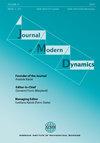罗伊·阿德勒及其作品的持久影响
IF 1
1区 数学
Q2 MATHEMATICS
引用次数: 0
摘要
1961年,Roy Adler(1931–2016)在Kakutani Shizuo的指导下,以题为“关于保测度变换的一些代数方面”的论文在耶鲁大学获得博士学位。他的整个职业生涯都在IBM Thomas J.Watson研究中心度过,多次短期和长期访问大学。他是美国文理学院、美国数学学会和纽约文理学院的研究员。他还曾在美国数学学会董事会任职。他的开创性科学成就包括拓扑熵的发明,动力学系统的马尔可夫划分的首次应用,以及符号动力学在双曲几何和信息论编码问题中的应用。罗伊对遍历理论和符号动力学的兴趣促使他开发了一种算法来设计代码,以满足数据存储和传输信道的约束。由合著者Don Coppersmith和Martin Hassner撰写的一篇记录这些发展的论文获得了IEEE信息理论组1985年最佳论文奖。IBM授予罗伊第四届高原发明成就奖、两项IBM研究杰出创新奖、一项杰出技术成就奖和2000年研究专利组合奖。罗伊在遍历理论和符号动力学方面发表了50多篇出版物,并在编码、打印、脊椎建模、x射线数据采集和密码学方面获得了10项专利。他还是几位年轻数学家的一位富有爱心和鼓舞人心的导师。他是一个有着敏锐而干巴巴的智慧的知识分子,他的爱好包括美食、歌剧、钓鱼、好朋友,最重要的是他的家人。罗伊嫁给了1990年去世的奥黛丽·万纳,然后嫁给了朱迪斯·赫沙夫。他是两个孩子Caroline Kosaka和Michael Adler的父亲,他们是他的继子和孙子。罗伊对遍历理论和拓扑动力学最重要的贡献可能是他引入了拓扑熵,作为几年前A.N.Kolmogorov[33]定义的测度论动态熵的拓扑类似物。拓扑熵的一个版本可以在W.Parry[36]和C.Shannon[42]的早期工作中找到,但仅适用于有限类型的移位。罗伊基础论文中给出的定义本文章由计算机程序翻译,如有差异,请以英文原文为准。
Roy Adler and the lasting impact of his work
Roy Adler (1931–2016) earned his Ph.D. in 1961 from Yale University under the supervision of Shizuo Kakutani with a dissertation titled “On Some Algebraic Aspects of Measure Preserving Transformations.” His entire career was spent at the IBM Thomas J. Watson Research Center, with many short-term and longterm visits to universities. He was a fellow of the American Academy of Arts and Sciences, the American Mathematical Society, and the New York Academy of Arts and Sciences. He also served on the Board of Trustees of the American Mathematical Society. Among his seminal scientific achievements are the invention of topological entropy, the first applications of Markov partitions for dynamical systems and the application of symbolic dynamics to coding problems in hyperbolic geometry and information theory. These will be discussed in more detail later on. Roy’s interest in ergodic theory and symbolic dynamics led him to develop an algorithm to design codes to meet the constraints for data storage and transmission channels. A paper, including co-authors, Don Coppersmith and Martin Hassner, documenting these developments won the IEEE Information Theory Group 1985 Best Paper prize. IBM awarded Roy a Fourth Plateau Invention Achievement award, two IBM Research Outstanding Innovation awards, an Outstanding Technical Achievement award and the 2000 Research Patent Portfolio award. Roy was a contributor to more than 50 publications, in ergodic theory and symbolic dynamics, and 10 patents on coding, printing, spine modeling, x-ray data acquisition and cryptography. He was also a caring and inspiring mentor to several young mathematicians. An intellectual with a sharp and dry wit, his passions included great food, opera, fishing, good friends, and most of all his family. Roy was married to Audrey Wanner who passed away in 1990 and then to Judith Hershaft. He was a dedicated and adoring father to his two children, Caroline Kosaka and Michael Adler, his stepchildren and grandchildren. Probably Roy’s most important contribution to ergodic theory and topological dynamics was his introduction of topological entropy as the topological analogue of the measure-theoretic dynamical entropy that had been by defined by A. N. Kolmogorov [33] just a few years earlier. A version of topological entropy can be found in earlier work of W. Parry [36] and C. Shannon [42], but only for shifts of finite type. The definition given in Roy’s foundational paper
求助全文
通过发布文献求助,成功后即可免费获取论文全文。
去求助
来源期刊
CiteScore
1.30
自引率
0.00%
发文量
11
审稿时长
>12 weeks
期刊介绍:
The Journal of Modern Dynamics (JMD) is dedicated to publishing research articles in active and promising areas in the theory of dynamical systems with particular emphasis on the mutual interaction between dynamics and other major areas of mathematical research, including:
Number theory
Symplectic geometry
Differential geometry
Rigidity
Quantum chaos
Teichmüller theory
Geometric group theory
Harmonic analysis on manifolds.
The journal is published by the American Institute of Mathematical Sciences (AIMS) with the support of the Anatole Katok Center for Dynamical Systems and Geometry at the Pennsylvania State University.

 求助内容:
求助内容: 应助结果提醒方式:
应助结果提醒方式:


